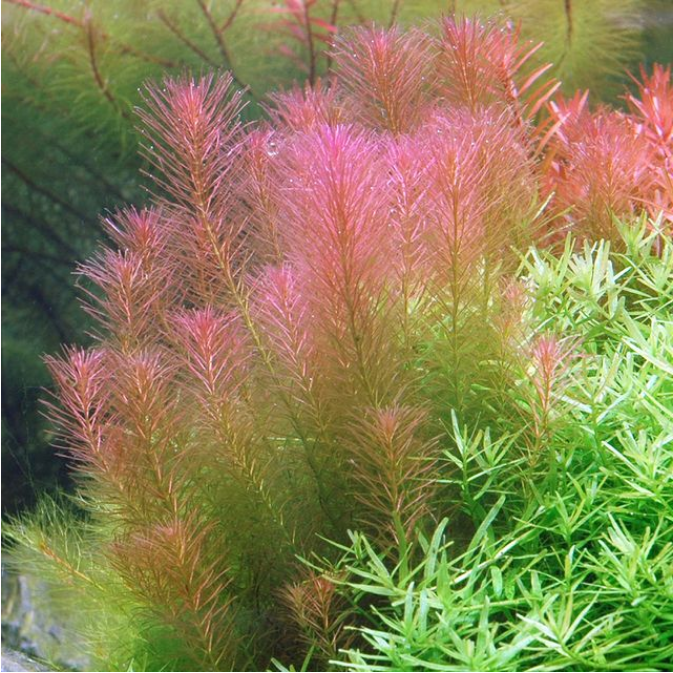Aquascapeplants Rotala wallichii
Out of stock
Aquascapeplants Rotala wallichii is a fine tiny leave plant with pink to red leaves. The plant is looks best when planted in bunch.
- Very fine delicate leaves
- Reddish-brown to pink colours
- Very nice in a large group
-
Complete botanical name Rotála wallíchii (Hook. f.) Koehne Family Lythraceae Genus Rotala Difficulty difficult Usage Accent (red), Background, Midground, Nano tanks Aquascaping fine-leaved, very colourful plant for accents Growth fast pH value 5 – 7 Temperature tolerance 15 – 30°C
د.إ27.00 د.إ30.00
Sold out!
Related products
-
Sold out!Live Plants & Neutrients, Plants, Tissue Culture Cup
Aquascapeplants Helanthium tenellum Green
0 out of 5(0)Size: Cup
Helanthium tenellum is a true lawn effect runner plant.
- Grass like lawn effect
- Narrow leaves
- Foreground plant
- Intermediate level maintenance
- Covers foreground fast with runners
Helanthium tenellum ‘Green’ (Echinodorus tenellus ‘Green’, Pygmy Chain Sword, Green Pygmy Chain Sword)
QUICK NOTES:
Difficulty: Easy
Type: Rosette plant with stolons (runners)
Size: 1-7 cm in height
Position and Usage: Carpet, Lawn and Foreground
Growth rate: Fast
Lighting: 3/5 – 5/5
Temperature: 18 – 35°C
Water Conditions: pH between 5 to 7.5, Soft to medium soft water (0-14 dKH)
CO2: Not required but recommended
Propagation: Runners (Stolons)
Special Requirements: Nutrient rich substrate, Iron supplementation, Neutral to acidic pH (common in planted aquariums)
Emersed: Yes – will produce flowers.
SKU: n/a -
Plants, Tissue Culture Cup
Aquascapeplants Hygrophila pinnatifida
0 out of 5(0)Maharashtra, Goa, Karnataka, Tamil Nadu are the states in India where Hygrophila pinnatifida is commonly found. However in the books its origin is from North India state of India, Uttar Pradesh.
- 3x times more plant quantity than other leading brands..
- Artistic leave pattern
- To artistic to be believed real
- Can be planted in soil or attached to the hardscape
- Relatively easy to grow and care
Synonyms Nomaphila pinnatifida Dalzell, Cardanthera pinnatifida (Dalzell) Benth. ex C.B.Clarke . Complete botanical name Hygróphila pinnatífida (Dalzell) Sreem. Family Acanthaceae Genus Hygrophila Difficulty medium Usage Epiphyte (growing on hardscape), Semi-emersed plant for open tanks, Midground, Foreground, group Height 5 – 40cm Width 10 – 30cm Growth medium Buy 5 or more for additional discount!
Buy 10 or more to get super discount!
SKU: n/a -
Aquascape Essentials, Plants
Moss Ball Pet
0 out of 5(0)Moss Pet is a perfect desktop living decoration.The moss ball is actual living moss and it does grow with time. The moss pet can be easily maintained and can be carried along.
Each Moss Ball Pet Jar has decorative pebbles and a small drift wood for detailing.
SKU: n/aد.إ34.20 – د.إ59.40Price range: د.إ34.20 through د.إ59.40 This product has multiple variants. The options may be chosen on the product page -
Aquascape Essentials, Aquascape Tools, Plants, Accessories
FLOURISH GLUE GEL TYPE 8G
0 out of 5(0)Size: 8 gFlourish Glue is a superior cyanoacrylate gel for attaching moss and plants to rocks, driftwood, and even gravel. It’s uniquely useful when planting bunch plants. Simply apply Flourish Glue, plant as usual and the plants stay rooted in the substrate. It bonds within seconds and has excellent control, hold and durability characteristics. It can even be used underwater. Flourish Glue can be used for any aquascaping in freshwater or saltwater aquariums or for any plastics repairs.
KEY FEATURES:
- Cyanoacrylate adhesive
- Attach moss and plants to rocks, driftwood, and even gravel
- No more thread, no more weights
- Bonds within seconds
- Can be used underwater
DIRECTIONS:
Dispense a small amount of glue prior to each use. Apply a small amount of glue to moss or plant roots and press against desired surface for 20 seconds. For bunch plants, apply glue and plant as usual. Wipe tip free of glue before replacing the cap.SKU: SE3116









